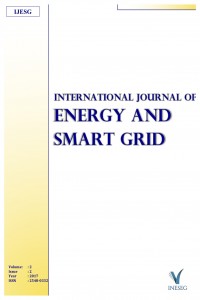Abstract
References
- Rathnayaka A, Potdar V, Dillon T, Hussain O, Kuruppu S., Goal-oriented prosumer community groups for the smart grid, IEEE Technol. Soc. Mag., 33 (2014), 41–8.
- Woldeyohannes A.D., Woldemichael D. E., Sustainable renewable energy resources utilization in rural areas, Renewable and Sustainable Energy Reviews, 66 (2016)1–9.
- Bird L., Lew D., Milligian M., Carlini E.M., et all., Wind and solar energy curtailment: A review of international experience, Renewable and Sustainable Energy Reviews, 65(2016), pp.577–586.
- Khare V., Nema S., Baredar P., Solar–wind hybrid renewable energy system:A review, Renewable and Sustainable Energy Reviews, 58(2016), 23–33.
- Al-falahi M.D.A., Jayasinghe S.D.G., Enshaei H., A review on recent size optimization methodologies for standalone solar and wind hybrid renewable energy system, Energy Conversion and Management, 143 (2017), pp. 252–274.
- Özçelik M.A., The Design and Implementation of PV -Based Intelligent Distributed Sensor LED Lighting in Daylight Exposed Room Environment, Sustainable Computing: Informatics and Systems, 13(2017), pp. 61-69.
- Liu G., Starke M., Xiao B., Tomsovic K., Robust optimisation-based microgrid scheduling with islanding constraints, IET Generation, Transmission & Distribution, 11(2017), 7, pp.1820-1828.
- The CERTS Microgrid Concept, https://certs.lbl.gov/sites/all/files/lbnl-50829.pdf, accessed September 2017.
Abstract
The
increase in the use of renewable energy systems in recent years has led to an
increase in the importance of work on micro-grids. In micro-grids, energy is
consumed where it is produced. This leads to a reduction in transmission and
power losses in the lines. At the same time, the negative effects of the
industrial plants that disrupt the quality of power are eliminated by the
micro-grid model and more efficient and reliable grids can be established.
Technological developments that impact each field have also affected the
electricity distribution grids. Problems such as inefficient energy
transmission systems caused by high power losses, problems in the integration
of renewable sources into the grid, inflexible demand, and wage problems make
it difficult to meet the increasing demand with the traditional structure. In
this study, a smart grid system was set up in the sample micro structure. The
system consist from a photovoltaic system with a consumer and a grid system
that feeds this consumer. There are a photovoltaic system and also a battery
group in the applied micro grid. The power of the photovoltaic system in the
micro-grid is continuously monitored by a microcontroller. The energy level
information of PV panel system, the battery, and grid are supplied by voltage
divider circuits to microcontroller. The information transmitted by the voltage
dividers to the microcontroller is evaluated by the control algorithm.
Considering account possible possibilities, the receiver is primarily fed by
the photovoltaic system, in other cases fed from the grid or the battery
system, thanks to the semiconductor switches used in the microcontroller
control. In addition, excess energy generated by the microcontroller is
transferred to the main grid. As a result of this application, the level of use
of the renewable energy system has been increased and the energy cost has been
reduced.
Keywords
References
- Rathnayaka A, Potdar V, Dillon T, Hussain O, Kuruppu S., Goal-oriented prosumer community groups for the smart grid, IEEE Technol. Soc. Mag., 33 (2014), 41–8.
- Woldeyohannes A.D., Woldemichael D. E., Sustainable renewable energy resources utilization in rural areas, Renewable and Sustainable Energy Reviews, 66 (2016)1–9.
- Bird L., Lew D., Milligian M., Carlini E.M., et all., Wind and solar energy curtailment: A review of international experience, Renewable and Sustainable Energy Reviews, 65(2016), pp.577–586.
- Khare V., Nema S., Baredar P., Solar–wind hybrid renewable energy system:A review, Renewable and Sustainable Energy Reviews, 58(2016), 23–33.
- Al-falahi M.D.A., Jayasinghe S.D.G., Enshaei H., A review on recent size optimization methodologies for standalone solar and wind hybrid renewable energy system, Energy Conversion and Management, 143 (2017), pp. 252–274.
- Özçelik M.A., The Design and Implementation of PV -Based Intelligent Distributed Sensor LED Lighting in Daylight Exposed Room Environment, Sustainable Computing: Informatics and Systems, 13(2017), pp. 61-69.
- Liu G., Starke M., Xiao B., Tomsovic K., Robust optimisation-based microgrid scheduling with islanding constraints, IET Generation, Transmission & Distribution, 11(2017), 7, pp.1820-1828.
- The CERTS Microgrid Concept, https://certs.lbl.gov/sites/all/files/lbnl-50829.pdf, accessed September 2017.
Details
| Journal Section | Research Article |
|---|---|
| Authors | |
| Publication Date | December 30, 2017 |
| Published in Issue | Year 2017 Volume: 2 Issue: 2 |
Cited By
Effect of Temperature on The I-V and P-V Curves of The Photovoltaic Cell
Iğdır Üniversitesi Fen Bilimleri Enstitüsü Dergisi
https://doi.org/10.21597/jist.978148
All articles published by IJESG are licensed under the Creative Commons Attribution 4.0 International License. This permits anyone to copy, redistribute, remix, transmit and adapt the work provided the original work and source is appropriately cited.


